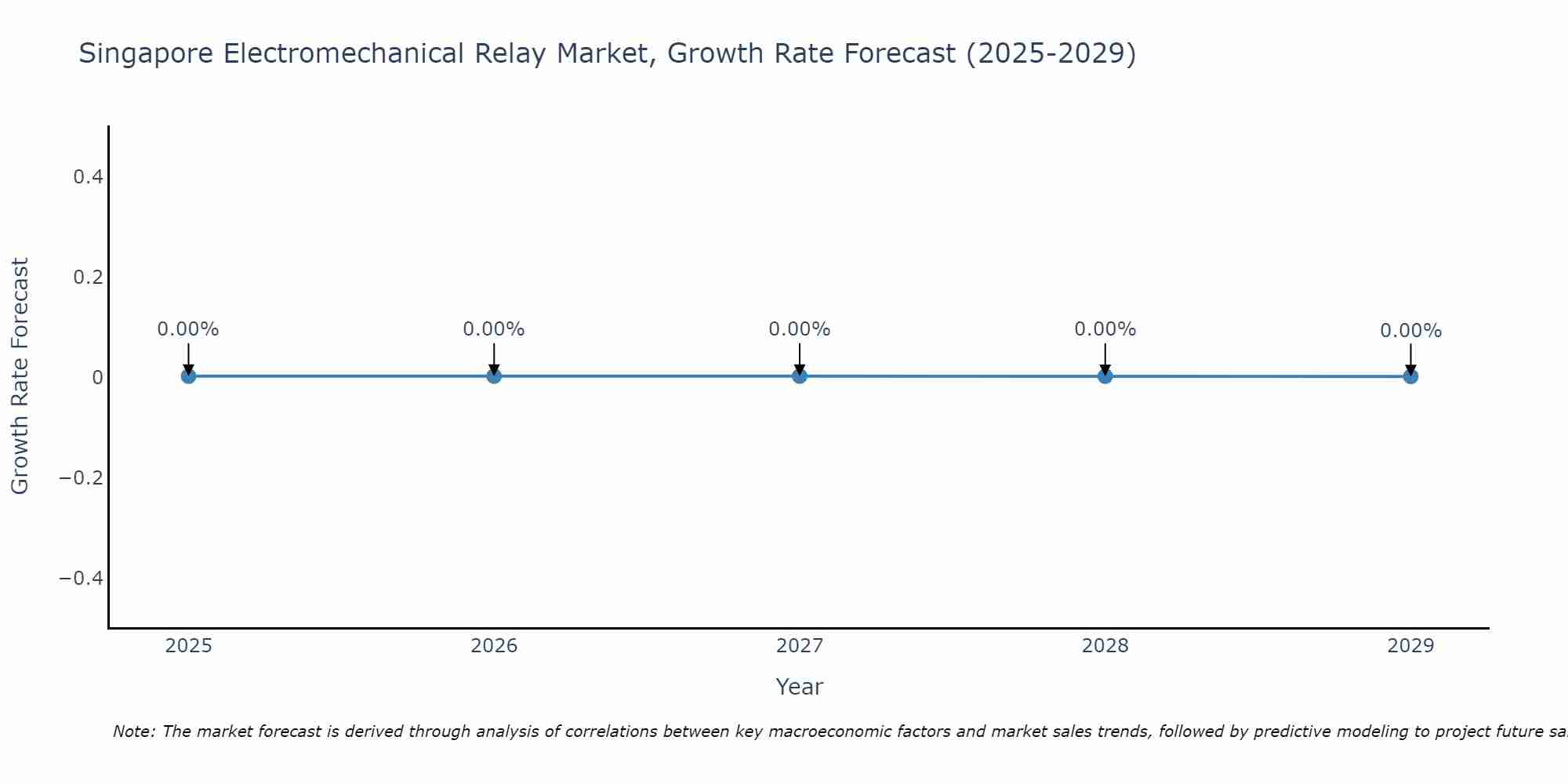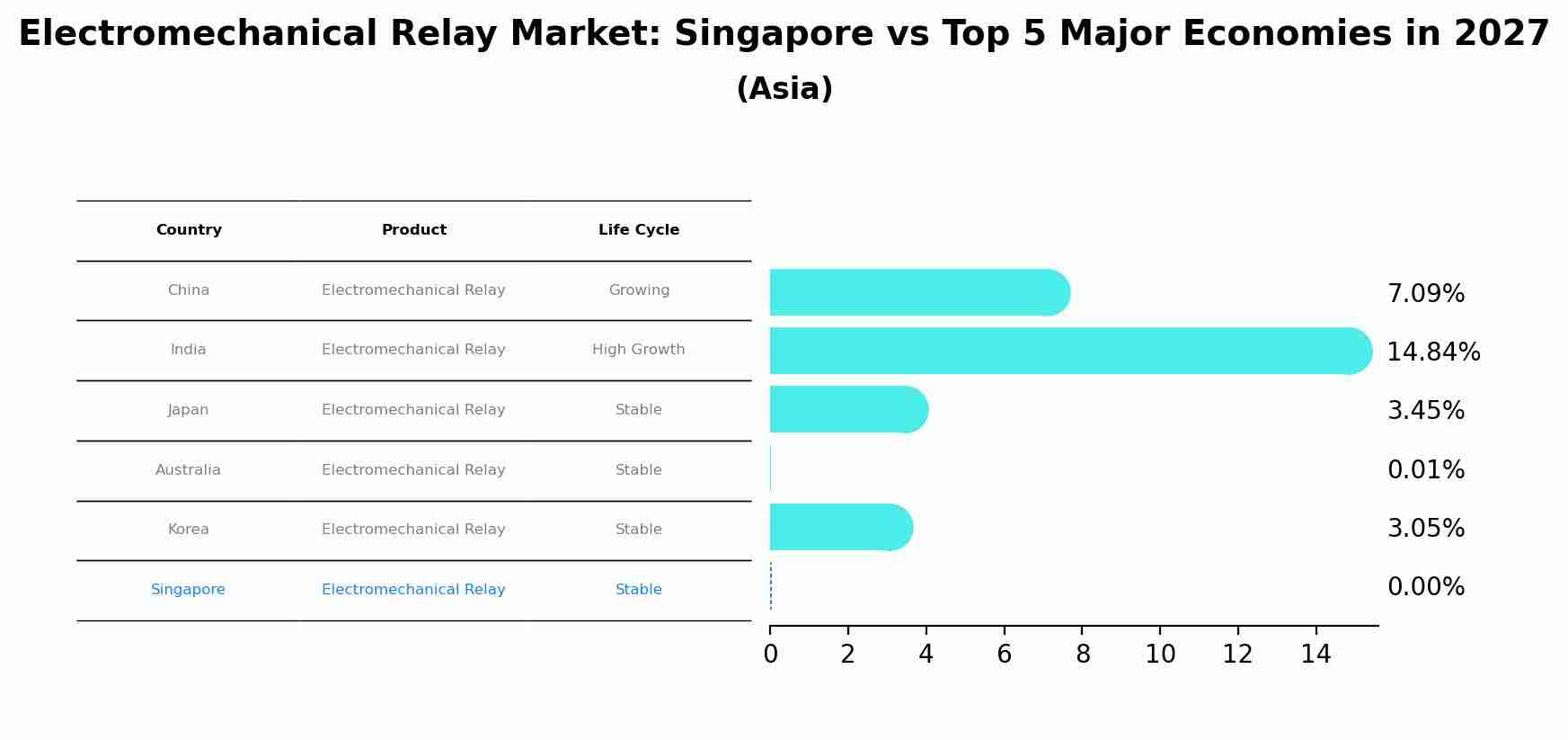Singapore Electromechanical Relay Market (2025-2031) Outlook | Industry, Revenue, Share, Size, Analysis, Value, Growth, Trends, Forecast & Companies
| Product Code: ETC262287 | Publication Date: Aug 2022 | Updated Date: Aug 2025 | Product Type: Market Research Report | |
| Publisher: 6Wresearch | No. of Pages: 75 | No. of Figures: 35 | No. of Tables: 20 | |
Singapore Electromechanical Relay Market Size Growth Rate
The Singapore Electromechanical Relay Market is projected to witness mixed growth rate patterns during 2025 to 2029. Starting at 0.00% in 2025, the market peaks at 0.00% in 2027, and settles at 0.00% by 2029.

Electromechanical Relay Market: Singapore vs Top 5 Major Economies in 2027 (Asia)
By 2027, Singapore's Electromechanical Relay market is forecasted to achieve a stable growth rate of 0.00%, with China leading the Asia region, followed by India, Japan, Australia and South Korea.

Singapore Electromechanical Relay Market Synopsis
The electromechanical relay market in Singapore is anticipated to witness steady growth, driven by various industries` need for reliable switching solutions. Electromechanical relays are used to control electrical circuits by mechanically opening or closing contacts. They find application in sectors such as manufacturing, transportation, telecommunications, and power distribution. As industries modernize their systems and integrate automation, the demand for precise and durable relays is expected to rise. Manufacturers are likely to focus on developing relays with enhanced switching performance, compatibility with digital control systems, and resistance to environmental factors. The market`s trajectory will be influenced by technological advancements and the ongoing digital transformation across industries.
Drivers of the Market
The Singapore Electricity and Signal Testing Instruments Market are propelled by the need for accurate and reliable testing equipment in various industries, including electronics, telecommunications, and manufacturing. The expansion of Singapore electronics manufacturing sector relies heavily on testing instruments to ensure the quality and reliability of electronic components and devices. Additionally, the demand for high-speed and high-capacity communication networks fuels the need for signal testing instruments. Moreover, regulatory compliance and safety standards require rigorous testing, further boosting the market for testing instruments.
Challenges of the Market
The electromechnical relay market confronts challenges associated with the transition to solid-state relays and increased miniaturization. As solid-state relays gain popularity for their efficiency and durability, traditional electromechanical relays face competition. Manufacturers must adapt to this changing landscape by diversifying their product offerings. Additionally, ensuring the reliability and lifespan of miniature relays, which are commonly used in portable electronics, is critical.
COVID-19 Impact on the Market
The COVID-19 pandemic had a noticeable impact on the Singapore electromechanical relay market. As industries and manufacturing units faced disruptions, the demand for electromechanical relays used in various applications declined. Supply chain disruptions also affected the production and distribution of these components. However, with the gradual recovery of industries and an increased focus on automation and smart technology, the market is expected to recover as well. The adoption of advanced relays for industrial automation and control systems is likely to drive future growth.
Key Players in the Market
In the electromechanical relay market, global giants like Omron, Schneider Electric, and Siemens offer a wide range of relays and control products for various industrial and commercial applications. These companies have a strong presence in Singapore, serving industries such as automation, energy, and telecommunications. Local distributors and solution providers, such as EE Automation and Control, facilitate the accessibility of these leading players` products. Leading players emphasize reliability and customization to meet the specific requirements of Singapore diverse sectors.
Key Highlights of the Report:
- Singapore Electromechanical Relay Market Outlook
- Market Size of Singapore Electromechanical Relay Market, 2024
- Forecast of Singapore Electromechanical Relay Market, 2031
- Historical Data and Forecast of Singapore Electromechanical Relay Revenues & Volume for the Period 2021-2031
- Singapore Electromechanical Relay Market Trend Evolution
- Singapore Electromechanical Relay Market Drivers and Challenges
- Singapore Electromechanical Relay Price Trends
- Singapore Electromechanical Relay Porter's Five Forces
- Singapore Electromechanical Relay Industry Life Cycle
- Historical Data and Forecast of Singapore Electromechanical Relay Market Revenues & Volume By Type for the Period 2021-2031
- Historical Data and Forecast of Singapore Electromechanical Relay Market Revenues & Volume By Reed Relays for the Period 2021-2031
- Historical Data and Forecast of Singapore Electromechanical Relay Market Revenues & Volume By Heavy Duty and High Voltage Relays for the Period 2021-2031
- Historical Data and Forecast of Singapore Electromechanical Relay Market Revenues & Volume By Aerospace/MIL-SPEC Relays for the Period 2021-2031
- Historical Data and Forecast of Singapore Electromechanical Relay Market Revenues & Volume By Industry Vertical for the Period 2021-2031
- Historical Data and Forecast of Singapore Electromechanical Relay Market Revenues & Volume By Consumer Electronics for the Period 2021-2031
- Historical Data and Forecast of Singapore Electromechanical Relay Market Revenues & Volume By Industrial Automation for the Period 2021-2031
- Historical Data and Forecast of Singapore Electromechanical Relay Market Revenues & Volume By Automotive for the Period 2021-2031
- Historical Data and Forecast of Singapore Electromechanical Relay Market Revenues & Volume By Aerospace for the Period 2021-2031
- Historical Data and Forecast of Singapore Electromechanical Relay Market Revenues & Volume By Others for the Period 2021-2031
- Singapore Electromechanical Relay Import Export Trade Statistics
- Market Opportunity Assessment By Type
- Market Opportunity Assessment By Industry Vertical
- Singapore Electromechanical Relay Top Companies Market Share
- Singapore Electromechanical Relay Competitive Benchmarking By Technical and Operational Parameters
- Singapore Electromechanical Relay Company Profiles
- Singapore Electromechanical Relay Key Strategic Recommendations
Frequently Asked Questions About the Market Study (FAQs):
1 Executive Summary |
2 Introduction |
2.1 Key Highlights of the Report |
2.2 Report Description |
2.3 Market Scope & Segmentation |
2.4 Research Methodology |
2.5 Assumptions |
3 Singapore Electromechanical Relay Market Overview |
3.1 Singapore Country Macro Economic Indicators |
3.2 Singapore Electromechanical Relay Market Revenues & Volume, 2021 & 2031F |
3.3 Singapore Electromechanical Relay Market - Industry Life Cycle |
3.4 Singapore Electromechanical Relay Market - Porter's Five Forces |
3.5 Singapore Electromechanical Relay Market Revenues & Volume Share, By Type, 2021 & 2031F |
3.6 Singapore Electromechanical Relay Market Revenues & Volume Share, By Industry Vertical, 2021 & 2031F |
4 Singapore Electromechanical Relay Market Dynamics |
4.1 Impact Analysis |
4.2 Market Drivers |
4.2.1 Growing industrial automation in Singapore leading to increased demand for electromechanical relays |
4.2.2 Rise in infrastructure development projects driving the need for electromechanical relays in construction and transportation sectors |
4.2.3 Technological advancements improving the efficiency and reliability of electromechanical relays |
4.3 Market Restraints |
4.3.1 Competition from alternative technologies such as solid-state relays impacting the growth of electromechanical relay market |
4.3.2 Volatility in raw material prices affecting the production costs of electromechanical relays |
4.3.3 Regulatory challenges and compliance requirements posing barriers to market expansion |
5 Singapore Electromechanical Relay Market Trends |
6 Singapore Electromechanical Relay Market, By Types |
6.1 Singapore Electromechanical Relay Market, By Type |
6.1.1 Overview and Analysis |
6.1.2 Singapore Electromechanical Relay Market Revenues & Volume, By Type, 2021-2031F |
6.1.3 Singapore Electromechanical Relay Market Revenues & Volume, By Reed Relays, 2021-2031F |
6.1.4 Singapore Electromechanical Relay Market Revenues & Volume, By Heavy Duty and High Voltage Relays, 2021-2031F |
6.1.5 Singapore Electromechanical Relay Market Revenues & Volume, By Aerospace/MIL-SPEC Relays, 2021-2031F |
6.2 Singapore Electromechanical Relay Market, By Industry Vertical |
6.2.1 Overview and Analysis |
6.2.2 Singapore Electromechanical Relay Market Revenues & Volume, By Consumer Electronics, 2021-2031F |
6.2.3 Singapore Electromechanical Relay Market Revenues & Volume, By Industrial Automation, 2021-2031F |
6.2.4 Singapore Electromechanical Relay Market Revenues & Volume, By Automotive, 2021-2031F |
6.2.5 Singapore Electromechanical Relay Market Revenues & Volume, By Aerospace, 2021-2031F |
6.2.6 Singapore Electromechanical Relay Market Revenues & Volume, By Others, 2021-2031F |
7 Singapore Electromechanical Relay Market Import-Export Trade Statistics |
7.1 Singapore Electromechanical Relay Market Export to Major Countries |
7.2 Singapore Electromechanical Relay Market Imports from Major Countries |
8 Singapore Electromechanical Relay Market Key Performance Indicators |
8.1 Average response time for technical support and maintenance services |
8.2 Rate of adoption of IoT-enabled electromechanical relays |
8.3 Energy efficiency improvements in electromechanical relay designs |
8.4 Percentage of repeat customers indicating satisfaction and loyalty |
8.5 Number of new product developments and innovations introduced in the market |
9 Singapore Electromechanical Relay Market - Opportunity Assessment |
9.1 Singapore Electromechanical Relay Market Opportunity Assessment, By Type, 2021 & 2031F |
9.2 Singapore Electromechanical Relay Market Opportunity Assessment, By Industry Vertical, 2021 & 2031F |
10 Singapore Electromechanical Relay Market - Competitive Landscape |
10.1 Singapore Electromechanical Relay Market Revenue Share, By Companies, 2024 |
10.2 Singapore Electromechanical Relay Market Competitive Benchmarking, By Operating and Technical Parameters |
11 Company Profiles |
12 Recommendations |
13 Disclaimer |
- Single User License$ 1,995
- Department License$ 2,400
- Site License$ 3,120
- Global License$ 3,795
Search
Related Reports
- ASEAN Bearings Market (2025-2031) | Strategy, Consumer Insights, Analysis, Investment Trends, Opportunities, Growth, Size, Share, Industry, Revenue, Segments, Value, Segmentation, Supply, Forecast, Restraints, Outlook, Competition, Drivers, Trends, Demand, Pricing Analysis, Competitive, Strategic Insights, Companies, Challenges
- Europe Flooring Market (2025-2031) | Outlook, Share, Industry, Trends, Forecast, Companies, Revenue, Size, Analysis, Growth & Value
- Saudi Arabia Manlift Market (2025-2031) | Outlook, Size, Growth, Trends, Companies, Industry, Revenue, Value, Share, Forecast & Analysis
- Uganda Excavator, Crane, and Wheel Loaders Market (2025-2031) | Strategy, Consumer Insights, Analysis, Investment Trends, Opportunities, Growth, Size, Share, Industry, Revenue, Segments, Value, Segmentation, Supply, Forecast, Restraints, Outlook, Competition, Drivers, Trends, Demand, Pricing Analysis, Competitive, Strategic Insights, Companies, Challenges
- Rwanda Excavator, Crane, and Wheel Loaders Market (2025-2031) | Strategy, Consumer Insights, Analysis, Investment Trends, Opportunities, Growth, Size, Share, Industry, Revenue, Segments, Value, Segmentation, Supply, Forecast, Restraints, Outlook, Competition, Drivers, Trends, Demand, Pricing Analysis, Competitive, Strategic Insights, Companies, Challenges
- Kenya Excavator, Crane, and Wheel Loaders Market (2025-2031) | Strategy, Consumer Insights, Analysis, Investment Trends, Opportunities, Growth, Size, Share, Industry, Revenue, Segments, Value, Segmentation, Supply, Forecast, Restraints, Outlook, Competition, Drivers, Trends, Demand, Pricing Analysis, Competitive, Strategic Insights, Companies, Challenges
- Angola Excavator, Crane, and Wheel Loaders Market (2025-2031) | Strategy, Consumer Insights, Analysis, Investment Trends, Opportunities, Growth, Size, Share, Industry, Revenue, Segments, Value, Segmentation, Supply, Forecast, Restraints, Outlook, Competition, Drivers, Trends, Demand, Pricing Analysis, Competitive, Strategic Insights, Companies, Challenges
- Israel Intelligent Transport System Market (2025-2031) | Strategy, Consumer Insights, Analysis, Investment Trends, Opportunities, Growth, Size, Share, Industry, Revenue, Segments, Value, Segmentation, Supply, Forecast, Restraints, Outlook, Competition, Drivers, Trends, Demand, Pricing Analysis, Competitive, Strategic Insights, Companies, Challenges
- Uganda Precast and Aggregate Market (2025-2031) | Strategy, Consumer Insights, Analysis, Investment Trends, Opportunities, Growth, Size, Share, Industry, Revenue, Segments, Value, Segmentation, Supply, Forecast, Restraints, Outlook, Competition, Drivers, Trends, Demand, Pricing Analysis, Competitive, Strategic Insights, Companies, Challenges
- Australia IT Asset Disposal Market (2025-2031) | Strategy, Consumer Insights, Analysis, Investment Trends, Opportunities, Growth, Size, Share, Industry, Revenue, Segments, Value, Segmentation, Supply, Forecast, Restraints, Outlook, Competition, Drivers, Trends, Demand, Pricing Analysis, Competitive, Strategic Insights, Companies, Challenges
Industry Events and Analyst Meet
Our Clients
Whitepaper
- Middle East & Africa Commercial Security Market Click here to view more.
- Middle East & Africa Fire Safety Systems & Equipment Market Click here to view more.
- GCC Drone Market Click here to view more.
- Middle East Lighting Fixture Market Click here to view more.
- GCC Physical & Perimeter Security Market Click here to view more.
6WResearch In News
- Doha a strategic location for EV manufacturing hub: IPA Qatar
- Demand for luxury TVs surging in the GCC, says Samsung
- Empowering Growth: The Thriving Journey of Bangladesh’s Cable Industry
- Demand for luxury TVs surging in the GCC, says Samsung
- Video call with a traditional healer? Once unthinkable, it’s now common in South Africa
- Intelligent Buildings To Smooth GCC’s Path To Net Zero













